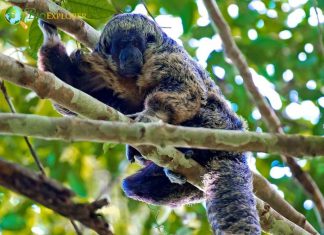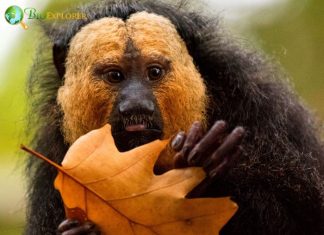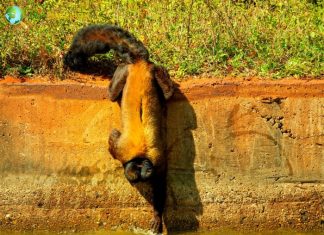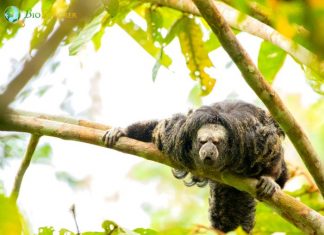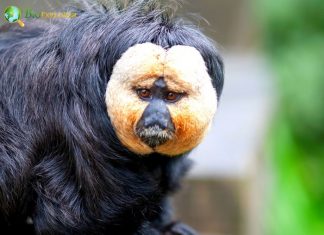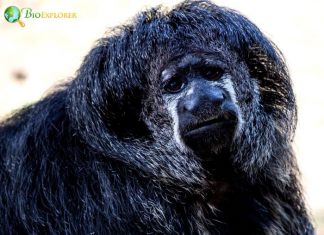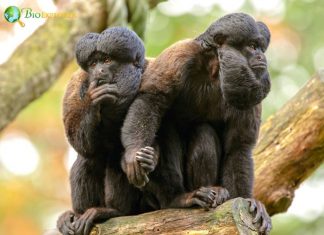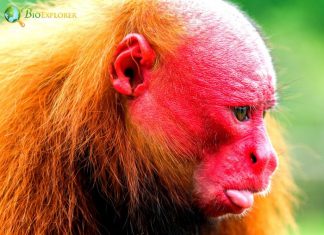Mittermeier’s Tapajós Saki
Species Name: Pithecia mittermeieri
Mittermeier's Tapajós Saki (Pithecia mittermeieri) is a disputed species of saki monkey, a type of New World monkey. Populations of this species were previously classified as Tapajós River saki (Pithecia irrorata). Still, a 2014 study described these populations as a separate species, Pithecia mittermeieri, based on their distinctive fur.
Miller’s Saki
Species Name: Pithecia milleri
Miller's Saki (Pithecia milleri), also called Miller's monk saki, is a species of the saki family, a type of New World monkey. Miller's sakis are diurnal and quadrupedal leapers. They usually move on all fours but can be seen swinging bipedally on large branches before leaping to another tree.
White-nosed Saki
Species Name: Chiropotes albinasus
The white-nosed saki (Chiropotes albinasus) is bearded, a New World monkey species native to the Amazon rainforest of south-central Brazil. White-nosed sakis are sometimes found in large social groups of 18-30 individuals. Their main reason for traveling is the food search.
Ryland’s Bald-faced Saki
Species Name: Pithecia rylandsi
The Ryland's Bald-Faced Saki (Pithecia rylandsi) is a controversial species of saki monkey, a New World monkey species. It is one of the largest sakis. This South American monkey was named after Brazilian primatologist Anthony Rylands, a former professor of vertebrate zoology at the Federal University of Minas Gerais and founding editor of the journal Neotropical Primates.
Vanzolini’s Bald-faced Saki
Species Name: Pithecia vanzolinii
Vanzolini's Bald-Faced Saki (Pithecia vanzolinii) is a species of saki monkey, a species of New World monkey. Vanzolini's bald-faced saki monkey was first cataloged by naturalist Alfonso Ollala in 1936. His account describes a monkey with a long, fluffy tail and golden fur on its limbs.
Uta Hick’s Bearded Saki
Species Name: Chiropotes utahicki
Uta Hick's Bearded Saki (Chiropotes utahicki) is an endangered species of bearded saki, a New World monkey species. It was named after Uta Hick, a German primatologist who cared for bearded sakis at Cologne Zoo.
Bearded Saki
Species Name: Chiropotes chiropotes
The bearded sakis or cuxiús are five species of New World monkeys classified in the genus Chiropotes. Bearded saki shows slight sexual dimorphism: males are usually taller and have longer, more prominent beards than females.
Pissinatti’s Bald-faced Saki
Species Name: Pithecia pissinattii
Pissinatti's Sakior or Pissinatti's bald-faced saki (Pithecia pissinattii), is a controversial species of saki monkey, a New World monkey. This species is named after Alcides Pissinatti, a Brazilian veterinarian who pioneered the breeding of endangered Brazilian primates.
Ornate Titi
Species Name: Plecturocebus ornatus
The ornate titi (Plecturocebus ornatus) is a species of titi and the smallest member of the Pitheciidae family, including the uakari and saki monkeys. Ornate titis have a monogamous mating system. A couple has a strong bond and stays together for years.
Isabel’s Saki
Species Name: Pithecia isabela
Isabel's Saki (Pithecia isabela) is a New World monkey species, native to a small part of northern Peru. The species was named in honor of Isabel Godin des Odonais, an 18th-century Ecuadorian noblewoman who traveled across South America to find her husband.
Hairy Saki
Species Name: Pithecia hirsuta
The hairy saki (Pithecia hirsuta) is a species of saki monkey, a New World primate species. The species was identified by Johann Baptist von Spix in 1823 but later merged with the Mönk saki (P. monachus). Then, a 2014 study revived it as a separate species due to differences in fur coloration.
Red-backed Bearded Saki
Species Name: Chiropotes sagulatus
The red-backed bearded saki (Chiropotes chiropotes), also known as Guianan Bearded Saki, is a New World monkey native to South America. They live in groups of about 40 members of both sexes, sometimes separated into groups when traveling or foraging, their primary occupation.
Gray’s Bald-faced Saki
Species Name: Pithecia irrorata
Gray's Bald-faced Saki (Pithecia irrorata), also known as Rio Tapajós saki, is a New World monkey native to South America. These monkeys are renowned for being reclusive because they avoid humans and quiet nature.
Golden-faced Saki
Species Name: Pithecia chrysocephala
The golden-faced saki (Pithecia chrysocephala) is a New World monkey found on the northern side of the Amazon on both sides of the Rio Negro in Brazil. This species was previously classified as a subspecies of white-faced saki (Pithecia pithecia) but was upgraded to full species status in 2014.
Equatorial Saki
Species Name: Pithecia aequatorialis
The Equatorial Saki, also known as the red-bearded Saki, is a species of saki monkey and New World monkey. They are most common in riparian, seasonally flooded, and swampy forests but have also been seen in terra firme forests.
Cazuza’s Saki
Species Name: Pithecia cazuzai
Cazuza's Saki is native to northwestern Brazil. Populations of this species were previously classified as Rio Tapajós saki (Pithecia irrorata). Still, a 2014 study found that these populations had a pelage distinct from all other species in the genus and were therefore considered their own species, Pithecia cazuzai.
Burnished Saki
Species Name: Pithecia inusta
The Burnished saki is a species of saki monkey, a species of New World monkey. It is located in central Peru and a small part of adjacent Brazil. The species was described by Johann Baptist von Spix in 1823 but was later merged with the monk saki (Pythecia monachus).
White-footed Saki
Species Name: Pithecia albicans
The white-footed Saki, also called the white Saki or buff saki, is a species of saki monkey, a New World species native to western Brazil. They hang from branches and hold on with their hind legs while eating seeds and fruits.
Brown-backed Bearded Saki
Species Name: Chiropotes israelita
The brown-backed bearded Saki is one of 5 species of bearded Saki, a New World monkey species. Bearded sakis have a unique appearance. They are born with prehensile tails, which they retain for the first two months of their life. This allows them to cling to their mother's body. After this time, the tail becomes non-prehensile.
Guianan Saki
Species Name: Pithecia pithecia
The white-faced saki (Pithecia pithecia), also known as the golden-faced saki, Guianan saki, and Guyana saki, is a New World saki monkey species. Typically, they have a lifespan of around 14 years in the wild and have lived up to 36 years in captivity.
Geoffroy’s Monk Saki
Species Name: Pithecia monachus
Geoffroy's monk saki, also called monk saki, is a species of saki monkey, a New-World primate native to South America. A monk saki is one of seven species of New-World arboreal monkeys with a bushy, feathery tail.
Black Bearded Saki
Species Name: Chiropotes satanas
The black-bearded saki is a species of bearded saki, a species of New World monkey, one of the five remaining monkeys of its kind. Another striking feature is its signature beards. This species prefers primary rainforest, where lush tree canopies provide a relatively safe area out of sight and out of reach of several predators.
Aracá Uakari
Species Name: Cacajao ayresi
The Aracá uakari, also called the Ayres black uakari, is a newly described monkey species endemic to the northwestern Brazilian Amazon. The species was found by Jean-Philippe Boubli of the University of Auckland after following local Yanomamo Indians on their hunts along the Aracá River, a northern tributary of the Negro River.














